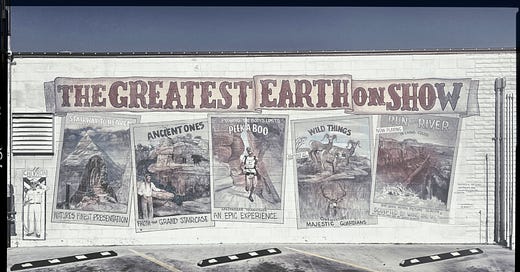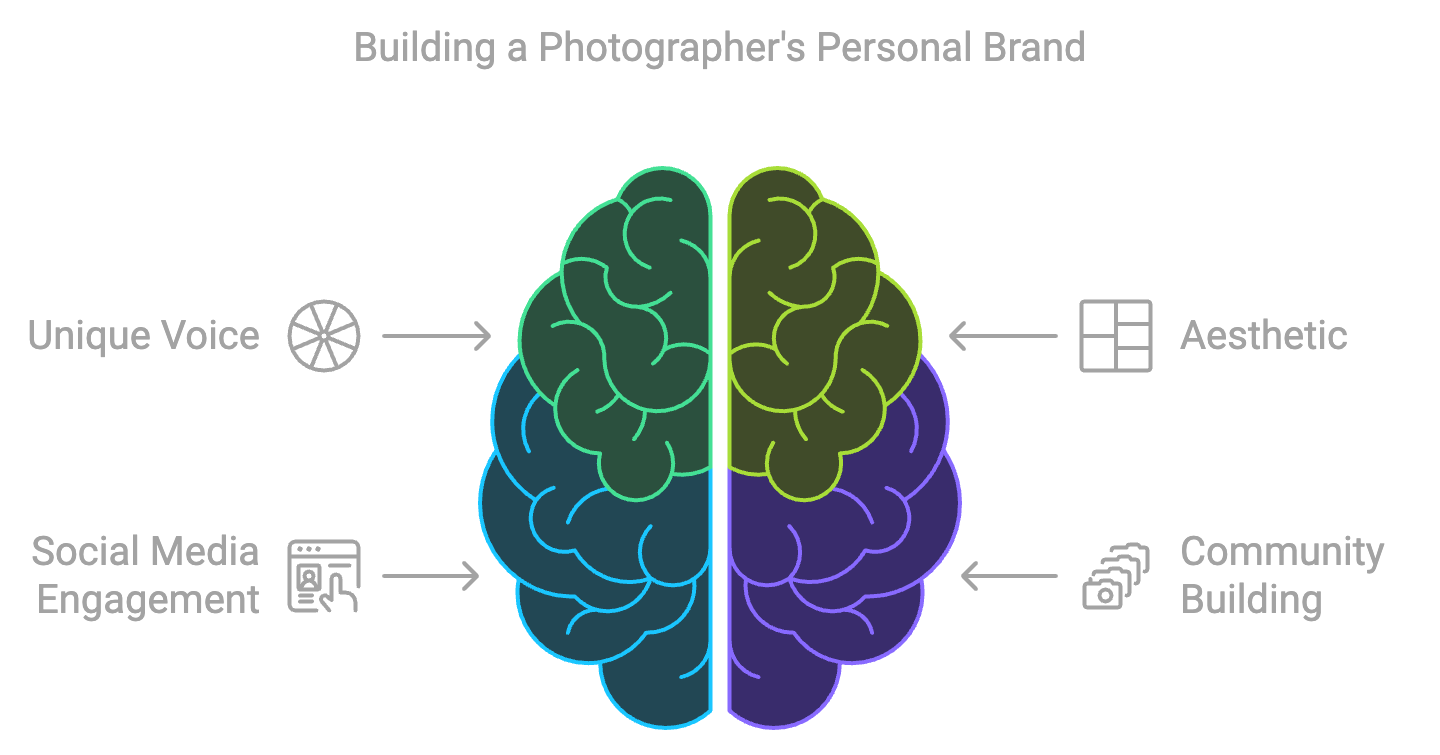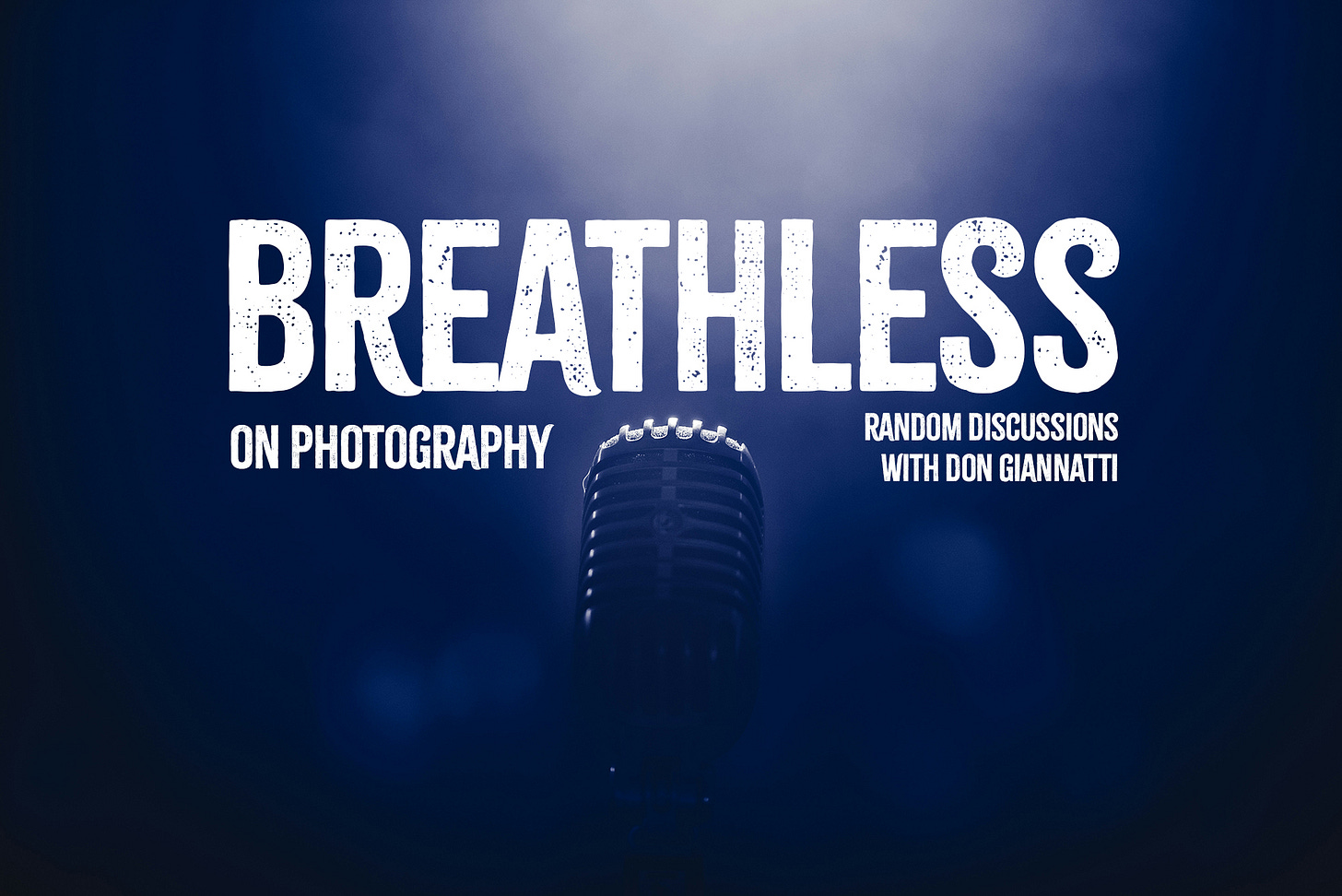Hi, and welcome to my little Substack corner. I write about photography, art, design, and the craft of living creatively. I am glad you are here. Consider subscribing to keep up with what I am doing. I promise not to bore you. If you would like to support my efforts, that would be amazing and so appreciated. Either way, I am super happy you are here.
For those who want to listen, this is an AI Podcast titled Deep Dive available through NotebookLM. If you like listening to these, here ya go. If you don’t like them, don’t click. S’all good.
The Power of Personal Projects
In professional photography—especially the commercial side—personal projects aren’t a creative luxury; they’re the elixer that keeps us inspired and evolving. These self-driven endeavors offer a playground for experimentation, a personal canvas where we stretch our boundaries and explore fresh techniques, styles, and narratives without the leash of client expectations or the weight of a campaign brief.
Personal projects give us something invaluable: freedom.
Freedom to dig deep into our artistic vision and follow instincts and ideas we might otherwise have to curb on commercial shoots. Here, we can test out the lighting, angles, or concepts that seem too bold or unconventional in a client’s eyes.
Not only will this sharpen skills, but it also creates a portfolio of work that represents our truest voice, our authentic voice—a collection that can make the difference when a brand or agency wants something distinctive, something beyond the cookie-cutter.
Cookie cutter is best handled by stock, or… (gulp) AI. And it surely will be. But authentic will be what is needed when they realize the stock stuff ain’t moving the needle.
These projects often act as a mirror, reflecting our growth and evolution as artists. They push us out of comfort zones, introduce new subjects, and may even surprise us with a whole new direction we hadn’t anticipated.
So, personal projects aren’t “passion projects”; they’re foundational to staying ahead, keeping creative hunger alive, and cultivating a style that’s both unmistakable and uniquely our own.
1. Creative Freedom
Personal projects provide photographers with the freedom to experiment with new techniques, styles, and subjects. Unlike commercial work, which often has specific guidelines and client expectations, personal projects allow photographers to pursue their interests and passions. This creative liberty can lead to innovative ideas and unique perspectives that may not emerge in a structured environment.
I used my GLOCAS project to have a bit of fun, and create a sandbox for play. GLOCAS = Girls Looking Off Camera At Stuff.
2. Skill Development
Engaging in personal projects is an excellent way for photographers to hone their skills. They can improve their technical abilities and artistic vision by challenging themselves with new concepts or techniques. Whether mastering a new camera setting, exploring different lighting conditions, or experimenting with post-processing techniques, personal projects encourage continuous learning and growth.
Jennifer Arce has been building her motion portfolio by trying different ideas.
3. Portfolio Expansion
Personal projects can significantly enhance a photographer's portfolio. They provide an opportunity to showcase work that reflects their true style and interests, which may differ from their commercial projects. A diverse portfolio that includes personal work can attract potential clients who resonate with the photographer's artistic vision, ultimately leading to more opportunities in the industry.
Ligia Cuevas Johnson has turned personal projects into books.
4. Building a Personal Brand
In a competitive market, establishing a strong personal brand is crucial for photographers. Personal projects allow photographers to define their unique voice and aesthetic, setting them apart from others in the field. By sharing their personal work on social media or photography platforms, they can engage with a broader audience and build a community around their artistic identity.
Upstate New York photographer, Larry Felton, has built a formidable portrait portfolio by working with real people around his town. It started as a project, and is now his forte.
5. Emotional Fulfillment
Photography is not just a profession; it is also a form of self-expression and emotional release. Personal projects can serve as a therapeutic outlet, allowing photographers to explore their thoughts, feelings, and experiences through their lens. This emotional connection to their work can lead to greater satisfaction and fulfillment, making photography a more rewarding pursuit.
Alex Baker was examining some of the issues of motherhood when this project emerged.
6. Networking Opportunities
Working on personal projects can open doors to new networking opportunities. Photographers can collaborate with other artists, models, or creatives, fostering relationships that may lead to future projects or referrals. Sharing personal work can also attract the attention of industry professionals, leading to potential partnerships or collaborations.
Carla McMahon decided to do a book on Gin Distilling. That led to a lot of introductions and many of those turned into clients.
Should You Do a Personal Project?
Personal projects are an essential aspect of a photographer's progressive journey. They provide creative freedom, facilitate skill development, enhance portfolios, build personal brands, offer emotional fulfillment, and create networking opportunities.
By dedicating time to personal projects, photographers can not only grow as artists but also find deeper meaning and joy in their craft.
Some ideas for personal projects
Deciding on a personal project as a photographer isn’t as simple as jumping on any random idea—though sometimes, an impulsive leap can bring a fresh spark. However, most photographers find that a mix of intuition and intention yields the best results.
Here’s a structured approach to help find that “just right” project that aligns with both your curiosity and creative goals.
Saturday, November 9, 2024.
A Discussion on the Value of Personal Projects.
Bring examples of your work to share if you are currently doing one. (Through ZOOM).
This is the invite link:
Join Zoom Meeting
Time: 11 AM Pacific.
On Zoom.
Please take a moment to learn how to use Zoom if you are not familiar.
How do we decide on a personal project?
1. Reflect on Personal Interests and Passions
Start by thinking about what truly excites you outside of photography. Maybe it’s travel, music, architecture, or stories from history. Passion often brings depth and persistence to a project, and audiences can sense the authenticity in the work.
Start: Make a list of three non-photography things you love or are deeply curious about. These may provide a thematic anchor for a meaningful project.
2. Identify Areas for Growth
Personal projects are ideal for experimenting with new techniques or refining skills that feel “rusty.” Think about what you want to master—maybe it’s lighting control, or posing, or macro photography, or maybe even post-processing. A project with a technical goal gives you a target to focus on and keeps the work purposeful.
Start: Ask yourself, “What’s one skill I wish I were better at?” Use the answer to shape the style or theme or goal of your project.
3. Consider Practicality and Feasibility
Balancing ambition with practicality is key. Consider factors like time, budget, and access to locations or subjects. Personal projects shouldn’t be a source of stress—they’re meant to inspire. A project that’s possible within your available resources can still be incredibly impactful. it’s what you do with it that matters the most.
Start: If a project idea seems too big, break it down. Find a way to start with a “mini-project” that allows you to test the waters without a massive commitment.
4. Challenge Yourself to Step Outside Your Comfort Zone
Personal projects are a chance to explore unfamiliar territory, which often leads to surprising growth. Choosing something that stretches your current abilities or subjects you’re not entirely comfortable with can push your creative boundaries.
Start: Reflect on past shoots that made you nervous or uncomfortable. Was it directing people? Trying extreme lighting? Consider a project that tackles this head-on. This can open more creative ideas for you while gaining practical skills.
5. Think About What You Want to Say with Your Work
Photography is a powerful storytelling medium. Ask yourself if there’s something you want to convey—a feeling, a commentary, or an exploration of a theme that resonates with you. Projects with an emotional or conceptual backbone tend to have a deeper impact. Perhaps your story can be helpful to a community that needs it.
Start: If you could tell a stranger one thing about the world through your photography, what would it be? Use that answer as a compass for your project’s direction.
But… Should You Think It All Through or Just Do It?
If an idea strikes that you feel passionately drawn to, give yourself permission to jump in without overthinking it. Let the project evolve organically—you can always adjust as you go. As of this writing, you can still follow your heart in this stuff.
However, a little planning can be a game-changer for more elaborate projects. When a project is complex or resource-intensive, some pre-planning around logistics, timeline, and objectives can make it sustainable.
For instance. I have seen a personal project that was shot in a very short amount of time;
Scott Montgomery
Robin O’Neill
And some projects expand over time, some even using time as part of the project.
Lars Schneider
Beth Galton
Ultimately, it’s a balance: let your gut point you toward an idea that resonates, then give it just enough structure so it doesn’t fizzle out. And remember—personal projects aren’t about perfection; they’re about exploration, growth, and creative play. Whether it’s a meticulously planned endeavor or a spur-of-the-moment pursuit, a good project feels personal, nearly obsessive, and ultimately keeps you excited.
Here are a few thoughts for personal projects that may give you some ideas. Feel free to stretch, chop, and otherwise dissect these for something you may go crazy for.
1. “Invisible Cities” Project
Inspired by Italo Calvino’s book Invisible Cities, this project centers around creating imaginative interpretations of places that don’t exist—or exist only in your mind. Imagine cities that defy the rules of reality, capturing what they might look, feel, and move like through your lens.
Photograph real locations but infuse them with surreal elements using lighting, odd angles, or creative compositing in post-production. Add layered textures or objects in unexpected ways to create a world that feels familiar yet otherworldly.
This project encourages you to push your conceptual skills and invites viewers into a dreamlike experience. It’s a powerful exercise in creating mood and story without relying on real-world context.
2. “Life in Miniature” Series
Focus on photographing miniature objects or scenes, such as a day in the life of tiny figures, micro landscapes, or mini food setups, as if they’re full-scale environments.
Create an entire world using tabletop and macro photography, crafting intricate narratives with miniature figures or everyday objects staged to look larger-than-life.
This project will stretch your lighting, composition, and storytelling skills while teaching you to think on a smaller scale. It’s a fun way to reimagine everyday items and explore the quirks of close-up photography.
3. “Lost and Found” Objects Project
Capture objects found in everyday spaces—items we might walk past without a second glance—and document their “life stories” through photography.
Go on walks, collect or photograph interesting discarded items or forgotten objects, and capture them in a way that tells a story. Experiment with dramatic lighting, shadow work, and unusual compositions to elevate these objects.
This project encourages you to see beauty and potential in things that seem insignificant. It’s also a great exercise in storytelling and finding emotion or nostalgia in inanimate objects.
4. “Moods of Light” Study
A project entirely focused on the transformative qualities of light, capturing how it affects mood, tone, and atmosphere without using any set subjects or people.
Choose different times of day, light sources, and weather conditions, then photograph scenes solely for their light characteristics. Play with extreme shadows, dramatic highlights, or diffuse lighting to see how each influences the scene.
This project will help you master the subtleties of lighting and enhance your understanding of how light alone can create emotion and depth, which is invaluable in commercial photography.
5. “Alter Ego” Portraits
Develop a portrait series capturing different “selves” of one person or multiple subjects, portraying aspects of personality that are hidden, exaggerated, or purely imaginary.
Collaborate with willing subjects to explore their inner worlds. Create a series of contrasting portraits, using props, lighting, and creative poses to show different sides of their character or alter egos they wish to reveal.
This project allows you to dig deep into psychological storytelling, using your skills to create a character narrative within a single frame. It’s a brilliant challenge for portrait photographers who want to push beyond conventional poses and expressions.
Each of these possible projects gives you room to experiment, interpret, and develop new techniques. If you’re feeling pulled toward one in particular or have other ideas to build on, let’s brainstorm!
Share your personal projects with me, and I will link them in a future post. Perhaps get a few more eyeballs on your work.
Happy shooting!!!
When you are ready, here is how I can help you succeed.
Group Mentorship: a small group of photographers who meet to show images, work on their portfolio, and build their businesses with help from a wonderful group. Lifetime membership for one fee.
One-on-one Mentorship: You and me - working together in an intense 6-month push to get you on the way to over $30K in additional revenue. The work we lay down will help you increase and scale your business for years ahead.
Thank you for supporting my work.














Ooooooooh! Great timing of this article! Im seating in the plane to Milan and this upcoming weekend I will be exploring Tuscany seaside for that particular reason! Personal project on film!!!!
Im about to read it during the flight and off we go driving and exploring Italian landscapes, towns, villages - no particular plan, just drive ahead and look for images 😁
Thanks for doing this... I am blown away. I'm on the run to go do a drone project for an antebellum home up the road from me about 40 miles, so I just skimmed over the article... but already has my mind racing with ideas. (I'm downloading this and will study this extensively and return to it often.) I love the authenticity angle... the "portfolio of our truest voice" - that really resonates. I started exploring some of your client's examples too. Truly good stuff Don, thanks for responding and doing so, so quickly!